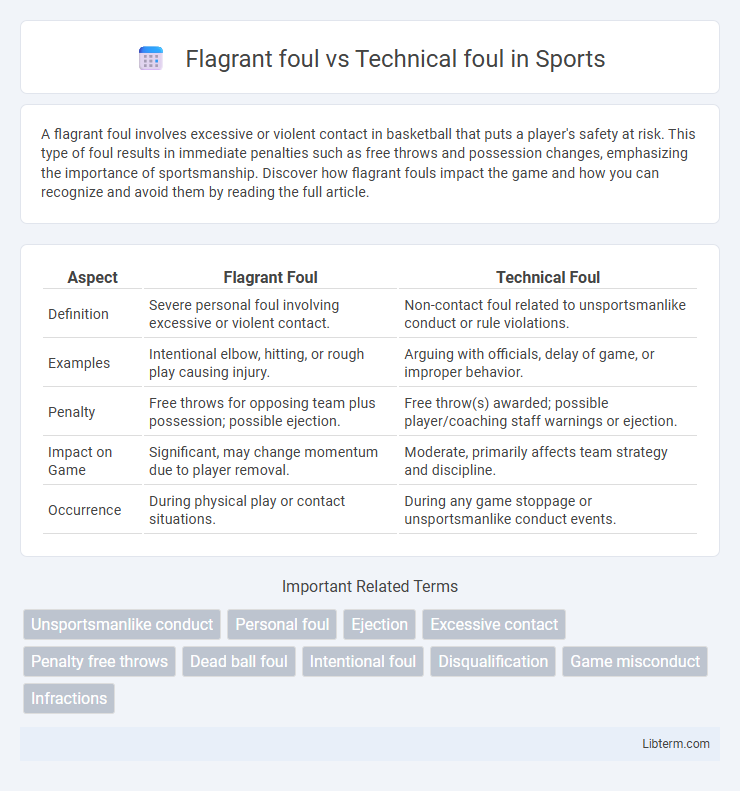A flagrant foul involves excessive or violent contact in basketball that puts a player's safety at risk. This type of foul results in immediate penalties such as free throws and possession changes, emphasizing the importance of sportsmanship. Discover how flagrant fouls impact the game and how you can recognize and avoid them by reading the full article.
Table of Comparison
| Aspect | Flagrant Foul | Technical Foul |
|---|---|---|
| Definition | Severe personal foul involving excessive or violent contact. | Non-contact foul related to unsportsmanlike conduct or rule violations. |
| Examples | Intentional elbow, hitting, or rough play causing injury. | Arguing with officials, delay of game, or improper behavior. |
| Penalty | Free throws for opposing team plus possession; possible ejection. | Free throw(s) awarded; possible player/coaching staff warnings or ejection. |
| Impact on Game | Significant, may change momentum due to player removal. | Moderate, primarily affects team strategy and discipline. |
| Occurrence | During physical play or contact situations. | During any game stoppage or unsportsmanlike conduct events. |
Understanding Flagrant Fouls: Definition and Criteria
A flagrant foul in basketball involves excessive or violent contact that poses a risk of injury, often categorized as Flagrant 1 or Flagrant 2 depending on severity, based on NBA rules. The criteria for a flagrant foul include hostility, unnecessary roughness, or repeated violations that go beyond common game conduct, emphasizing player safety and sportsmanship. Understanding these distinctions helps in differentiating flagrant fouls from technical fouls, which primarily address unsportsmanlike behavior without physical contact.
Technical Fouls Explained: What Constitutes a Technical?
A technical foul in basketball is called for unsportsmanlike conduct or violations not directly related to physical play, such as arguing with officials, delay of game, or using inappropriate language. Unlike flagrant fouls, which involve excessive or violent contact, technical fouls focus on behavior that disrupts the game's integrity or flow. Players or coaches receiving a technical foul may result in free throws for the opposing team and possession of the ball.
Key Differences Between Flagrant and Technical Fouls
Flagrant fouls involve severe physical contact deemed excessive or violent, often resulting in player ejection and potential suspensions. Technical fouls are non-contact violations related to unsportsmanlike conduct, such as arguing with officials or delay of game, typically resulting in free throws for the opposing team. The key difference lies in the nature of the infraction: flagrant fouls address dangerous physical play, while technical fouls address behavioral or procedural violations.
Common Scenarios: When Do Flagrant Fouls Occur?
Flagrant fouls typically occur during aggressive physical contact that endangers the safety of an opponent, such as excessive force in a foul or violent conduct. Common scenarios include hard fouls during fast breaks, late hits on shooters, or unnecessary roughness after a play. These fouls are assessed when the referee judges the action to be intentional or highly reckless, distinguishing them from technical fouls, which usually involve unsportsmanlike behavior without physical contact.
Examples of Actions Leading to Technical Fouls
Technical fouls in basketball often result from actions such as arguing with referees, unsportsmanlike conduct, or illegal substitutions, whereas flagrant fouls involve excessively aggressive physical contact like hitting an opponent or reckless fouls that can cause injury. Examples of actions leading to technical fouls include using inappropriate language, delay of game violations, or excessive timeouts. Understanding these distinctions helps maintain fair play and improves game flow.
Penalties and Consequences of Flagrant Fouls
Flagrant fouls in basketball result in severe penalties including immediate ejection of the player from the game and awarding the opposing team two free throws along with possession of the ball. These fouls are classified into Flagrant 1 or Flagrant 2, with Flagrant 2 carrying stricter consequences such as possible suspension in upcoming games by the league's disciplinary committee. Technical fouls, by contrast, generally penalize unsportsmanlike conduct with free throws awarded to the opponent but do not typically result in player ejection unless accumulated.
Impact of Technical Fouls on Game Flow
Technical fouls disrupt the game flow by stopping play and often resulting in free throws or possession changes, affecting team momentum and strategy. Unlike flagrant fouls, which primarily penalize physical violence with immediate ejections or suspensions, technical fouls target unsportsmanlike behavior, leading to increased game stoppages and heightened tension between teams. The accumulation of technical fouls can influence referee decisions and alter the overall pace and rhythm of the basketball game.
How Referees Evaluate Flagrant vs Technical Infractions
Referees evaluate flagrant fouls by assessing the severity and intent of excessive or violent contact that endangers player safety, often resulting in immediate ejection or fines. Technical fouls are judged based on unsportsmanlike behavior, such as verbal abuse or procedural violations, where intent is less violent but disrupts game integrity. Officials use specific criteria and video reviews to distinguish between physical aggression warranting a flagrant foul and behavioral misconduct classified as a technical foul.
Player Reactions and Team Strategies After Fouls
Player reactions to flagrant fouls often involve immediate confrontation or heightened aggression due to the perceived severity and intent of the contact, while technical fouls typically trigger frustration or strategic adjustments without physical retaliation. Teams employ specific strategies after flagrant fouls by focusing on maintaining composure and exploiting the free throws and possession rewards granted to the opposing team, often tightening defensive discipline to prevent further escalation. Following technical fouls, coaches commonly emphasize communication and mental toughness to minimize distractions and use the incident as a rallying point to boost team focus and execution.
Preventing Flagrant and Technical Fouls in Basketball
Preventing flagrant and technical fouls in basketball requires enforcing strict discipline and promoting sportsmanship among players and coaches. Coaches should emphasize rule adherence and respect for opponents and officials to reduce aggressive behaviors that lead to flagrant fouls. Implementing clear consequences and regular training on emotional control helps minimize technical fouls caused by unsportsmanlike conduct or dissent toward referees.
Flagrant foul Infographic

 libterm.com
libterm.com